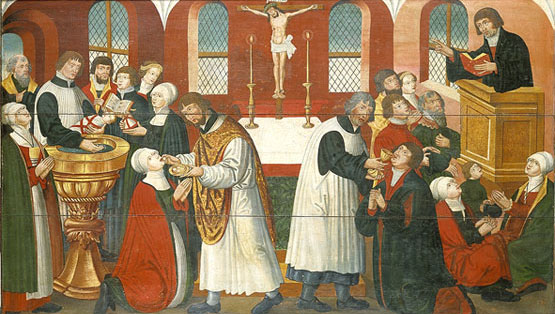Sacrament
The word “sacrament” had many different definitions across the Christian faith. The biggest differences in definitions were between the traditional Catholic view of sacraments and the Lutheran, reformed view of sacraments. Roman Catholics believed that a sacrament was one of the channels through which God graced humanity. Catholic tradition held that there were seven sacraments – five were considered “life-cycle” rituals and the other two were seen as sources of renewable grace. The “life cycle” sacraments were ones that represented one’s journey through life, beginning with baptism, then confirmation, marriage or ordination (if you were a priest), and finally the anointing of the dying. The other two “grace” sacraments were penance, which involved the confession to and absolution of sin by a priest, and the Eucharist, also known as the holy communion. Penance was the process of confessing to and being absolved of sin by a priest. This required acts of repentance, which usually included prayer, pilgrimage, or almsgiving. Indulgences were a creation of the papacy that allowed people to essentially buy forgiveness and escape punishment in purgatory.The Catholic tradition of baptism emphasized the practice of infant baptism, absolving the baby of original sin at an early age and initiating the baby into the body of believers. Parents wanted to ensure that their child would be accepted into heaven in case of death, since the high infant mortality rate during this time. During the sacrament of communion, also called the eucharist, Catholics practiced transubstantiation, in which the bread and wine presented by the priest were actually transformed into the body and blood of Christ, but maintained its physical appearance.
Building off of Luther’s doctrine of justification by faith alone, Protestant reformers defined a sacrament as an outward and visible sign of inward and and spiritual grace, and involved a promise of grace between the individual and God. As a result, they argued that the only sacraments were baptism and communion. These were true sacraments because they were based in scripture, specifically Christ’s baptism in the River Jordan and the celebration of the Last Supper in the New Testament. The other sacraments were seen as inventions of the Church because they lacked biblical support. For example, ordination into priesthood was not a sacrament because it did not require a promise of grace, and also because Luther believed in a “priesthood of all believers”, in which anyone could communicate with God, thus eliminating the need for a priest to mediate one’s relationship with God. Sacraments were meant to come from the authority of God, not the papacy.

Sacraments were a highly controversial topic during the Reformation that reflected social and political developments of the time period. The Reformation was considered a “ritual process”, in which people tried to define how a sacrament was holy, conferred grace, and they connected God to the believer. The three most contested sacraments, between Catholicism and Protestantism as well as within the reform movement itself, were penance, baptism, and the eucharist. The sacramental controversy began with Luther’s attack on the system of the indulgences that was related to the sacrament of penance. Luther saw this as a corrupt system because penance wasn’t technically a sacrament and that the forgiveness of sins was already promised through the faith of God. Luther’s view of penance was generally agreed upon by Protestant reformers. Protestants, however, did not have a unified view of the sacrament of baptism. Like Catholics, Luther and Zwingli preached infant baptism, but stressed that baptism did not equal salvation, rather it was a birthright, signifying the faith that God promised. In Lutheran and Zwinglian doctrine, baptism was considered a sacrament because it was an outward sign of inward change. Some reformers questioned infant baptism and began practicing adult baptism, or believer’s baptism, in which only those who proved themselves to be dedicated followers of Christ were eligible to be washed away of sin and granted new life. This led to the development of the Anabaptist movement, which translates to “re-baptism”. In regards to the eucharist, Luther maintained that the bread and wine existed alongside the presence of Christ, but the substance did not change, whereas Zwingli believed that the bread and wine signified the body and blood of Christ.
Works Cited
http://www.oxfordreference.com/view/10.1093/acref/9780195064933.001.0001/acref-9780195064933-e-1232?rskey=fhXmv6
&result=1224
Marshall, Peter. The Reformation: A Very Short Introduction. New York: Oxford University Press, 2009.